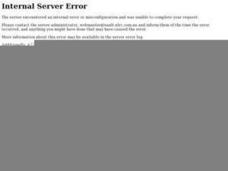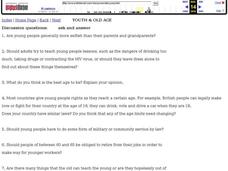Curated OER
Rights Abuses Around the World: What Can We Do?
Learners read about an Urgent Action information sheet from Amnesty International and a petition about human rights abuses against sexual minorities outside the USA. They discuss the situation, read about other similar cases and then...
Curated OER
Audience Influence
Students examine the media product and decide who the intended audience is. they invent a new audience profile and discuss ways the media image might be changed to suit this new audience. They may consider the language, images, sourcs or...
Curated OER
Phonemic Awareness Infusion
Students comprehend how to produce these pronuciation features, recognize the various blends of two and three letter consonant sounds, hear the sounds, produce them correctly when thinking about it, and practice correct pronuciation to...
Curated OER
Teaching the Tr'panier Trapezoid Kite
Students analyze how the parts of a system go together and how these parts depend on each other. They comprehend the forces in terms of strength and direction. Students observe, measure and describe weather indicators.
Curated OER
Estimating Volumes Of Household Containers
Students engage in a the estimation of volume for household containers and focus upon the usage of the metric system. They practice identifying the shapes that seem familiar and match shapes with quantities. Students interact with others...
Curated OER
The Great Escape
Students are introduced to human rights. They comprehend the democracy, legal and human rights and responsibilities, systems of justice, and skills in communication and working with others. Students work in teams. They make a long,...
Curated OER
Which Snowman is Different
In this visual discrimination worksheet, students circle the snowman in each row of three that is different from the other two. There are four rows of snowmen.
Curated OER
Editing Emily's Way: An Exercise in Diction and Its Implications
Students examine the poetry of Emily Dickinson and the diction in her poetry. In this poetry analysis lesson, students read Dickinson poetry and analyze the diction in the poems. Students journal about the poetry and rewrite their own...
Curated OER
Dueling Proverbs #2
In this secondary worksheet, students explore “dueling proverbs,” or proverbs that seem to contradict each other. The one page worksheet contains ten pairs of proverbs to be decoded. Answers are not provided.
Curated OER
Discussion Questions: Youth and Old Age
In this youth and old age discussion worksheet, students answer questions designed to stimulate their thinking about age. Students discuss honoring the elderly and disabilities, among other ideas relating to elderly people.
Curated OER
I Know I Can
Pupils explore the concept of philanthropy, and identify specific philanthropic agencies in their community. They participate in philanthropic opportunities, and develop persuasive arguments to encourage others to give of their own time...
Curated OER
Ane Frank: Writer
Tenth graders investigates a website to gather information on the Holocaust and Anne Frank. They compare Anne Frank's characteristics to other peers. Students explore specific examples and draw conclusions about human behavior.
Curated OER
Cultural Anthropology Study Using the Fundamentals of Geography and GPS
Students, in groups, operate the GPS unit, plotting each head stone with accompanying description. Two other students to log in data that corresponds to the given points. One student to note general observations
Curated OER
Lifting Fingerprints
Students examine the uniqueness of each other's fingerprints through the dusting and lifting of them. They use stamp pads, powder, brushes, etc. to collect as many different prints as they can.
Curated OER
Animals and Their Needs
Students identify the characteristics of living things and examine objects to see if they are living. They identify the needs of living things, in particular of animals and animal babies. They discuss how to care for pets.
Curated OER
Cyberspace
Students create original works of art or music and upload them to the Internet. They work individually or in a group. Then they collaborate with others to interpret, analyze, or alter the work.















